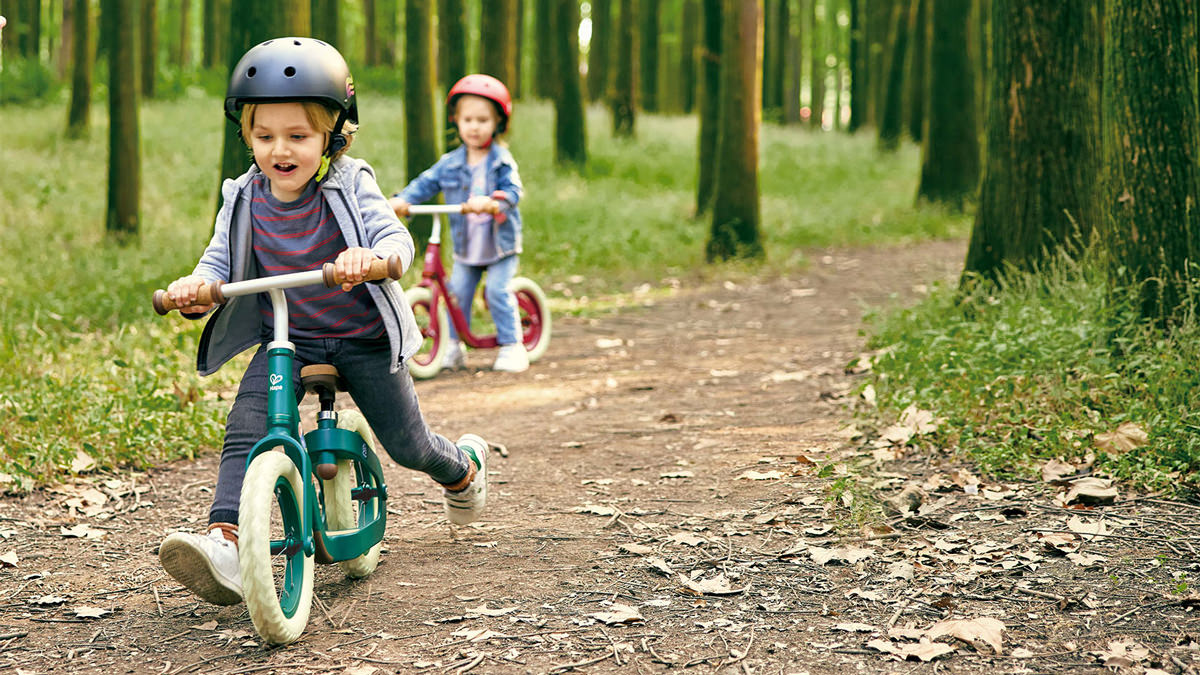02 October 2024
4 min.
It’s a well-known fact that balance bikes are beneficial in developing young children’s long-term, physical abilities and preparing them for a future pedal bike. But are there other plusses we might not be aware of?
Beyond strengthening core muscles and improving posture, balance bikes unlock a treasure trove of psychological benefits like improved mental health and communication skills. Read on to find out more about the often-overlooked mental advantages of balance bikes, exploring how they shape the minds and spirits of our youngest adventurers.

The first and most visible psychological benefit that balance bikes offer is a boost in confidence. When toddlers master the art of balancing and steering, it’s not just a physical milestone, but a massive leap in self-belief.
This newfound confidence spills over into other areas of their lives, making them more willing to take on new challenges and explore unfamiliar territories. Witnessing their own progress, from tentative first steps to zooming around with ease, instils a sense of achievement and independence.
Balance bikes also play a crucial role in developing emotional resilience. The learning process involves its fair share of wobbles and falls. However, it’s through these minor setbacks that toddlers learn the invaluable lesson of perseverance.
Each time they get back up and try again, they’re not just improving their balance; they’re building emotional strength. This resilience, cultivated in the early years, becomes a cornerstone of their psychological well-being, preparing them for the inevitable ups and downs of life.
The social landscape that balance bikes open up for toddlers is exciting and enriching. Parks and playgrounds become arenas for social interaction, where little riders learn to be effective communicators, navigate the complexities of sharing, taking turns, and playing safely with others.
These interactions are fundamental in developing empathy, communication skills, and an understanding of social cues. The balance bike becomes a tool for connection, fostering friendships and collaborative play among peers.
While zooming around on their balance bikes, toddlers are doing more than just having fun; they’re sharpening their cognitive abilities. The act of balancing requires a wide range of decision-making and problem-solving skills.
Toddlers must assess their speed, navigate obstacles, and make quick decisions to maintain balance and direction. This ongoing mental exercise enhances their cognitive flexibility and executive functioning skills, laying a solid foundation for future learning and adaptability.

Selecting an appropriate balance bike is important, as each age group has distinct developmental needs that impact both their physical and mental growth. Here are our top recs to get the most out of your child’s balance bikes, based on age:
At 12 Months
At just 12 months old, toddlers are taking their first bold steps into mobility. The Hape Scoot-Around is specially designed as a first balance bike, offering a stable and safe platform to develop early motor skills. It’s not just about the physical benefits; navigating their environment on this scoot-around also stimulates cognitive growth as they solve problems such as turning and balancing whilst enhancing spatial awareness.
At 18 Months
By 18 months, toddlers are eager to explore and conquer more challenging terrains. The My First Balance Bike steps in to meet this developmental milestone, perfectly balancing physical coordination with mental development. As they master steering and balancing, toddlers not only fine-tune their motor skills but also gain a significant boost in self-confidence and independence, key components of mental growth.
At 3 Years
Reaching 3 years, children are ready for more advanced challenges. The Learn to Ride Balance Bike offers just that, boosting not only physical agility but also critical thinking and problem-solving as they balance with confidence.
For adventures into the outdoors where terrain might be a bit more challenging, the Off Road Balance Bike is ideal for children learning to navigate more complex paths. Designed after motor and mountain bikes, it helps to promote cognitive development alongside physical prowess as they gain their next steps to independence.
As toddlers transition from tentative first glides to confident strides, they are not only mastering their balance bikes but also charting a course towards becoming self-assured, adaptable, and emotionally intelligent little humans. The choice of the right balance bike, tailored to meet the unique developmental needs of each age, further enriches this journey, ensuring that with every ride, children are not just moving forward on the path but growing in leaps and bounds towards holistic development.
